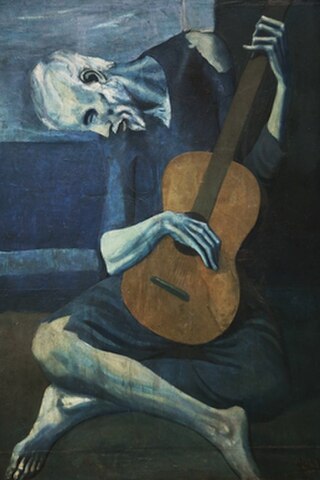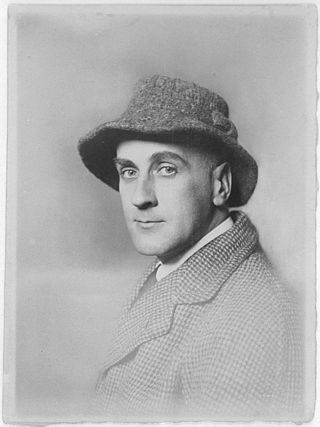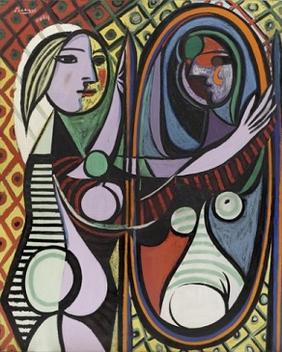
Georges Braque was a major 20th-century French painter, collagist, draughtsman, printmaker and sculptor. His most notable contributions were in his alliance with Fauvism from 1905, and the role he played in the development of Cubism. Braque's work between 1908 and 1912 is closely associated with that of his colleague Pablo Picasso. Their respective Cubist works were indistinguishable for many years, yet the quiet nature of Braque was partially eclipsed by the fame and notoriety of Picasso.

Pablo Ruiz Picasso was a Spanish painter, sculptor, printmaker, ceramicist and theatre designer who spent most of his adult life in France. One of the most influential artists of the 20th century, he is known for co-founding the Cubist movement, the invention of constructed sculpture, the co-invention of collage, and for the wide variety of styles that he helped develop and explore. Among his most famous works are the proto-Cubist Les Demoiselles d'Avignon (1907), and the anti-war painting Guernica (1937), a dramatic portrayal of the bombing of Guernica by German and Italian air forces during the Spanish Civil War.

Cubism is an early-20th-century avant-garde art movement that revolutionized European painting and sculpture, and inspired related artistic movements in music, literature, and architecture. In Cubist works of art, the subjects are analysed, broken up, and reassembled in an abstract form—instead of depicting objects from a single perspective, the artist depicts the subject from multiple perspectives to represent the subject in a greater context. Cubism has been considered the most influential art movement of the 20th century. The term cubism is broadly associated with a variety of artworks produced in Paris or near Paris (Puteaux) during the 1910s and throughout the 1920s.

Guernica is a large 1937 oil painting by Spanish artist Pablo Picasso. It is one of his best-known works, regarded by many art critics as the most moving and powerful anti-war painting in history. It is exhibited in the Museo Reina Sofía in Madrid.

Picasso's Rose Period represents an important epoch in the life and work of the Spanish artist Pablo Picasso which had a great impact on the developments of modern art. It began in 1904 at a time when Picasso settled in Montmartre at the Bateau-Lavoir among bohemian poets and writers. Following Picasso's Blue Period – which depicted themes of poverty, loneliness, and despair in somber, blue tones – Picasso's Rose Period represents more pleasant themes of clowns, harlequins and carnival performers, depicted in cheerful vivid hues of red, orange, pink and earth tones.

The Blue Period is a term used to define the works produced by Spanish painter Pablo Picasso between 1901 and 1904 when he painted essentially monochromatic paintings in shades of blue and blue-green, only occasionally warmed by other colors. These sombre works, inspired by Spain and painted in Barcelona and Paris, are now some of his most popular works, although he had difficulty selling them at the time.

Picasso's African Period, which lasted from 1906 to 1909, was the period when Pablo Picasso painted in a style which was strongly influenced by African sculpture, particularly traditional African masks and art of ancient Egypt, in addition to non-African influences including Iberian sculpture, and the art of Paul Cézanne and El Greco. This proto-Cubist period following Picasso's Blue Period and Rose Period has also been called the Negro Period, or Black Period. Picasso collected and drew inspiration from African art during this period, but also for many years after it.

Wilhelm Uhde was a German art collector, dealer, author, and critic, an early collector of modernist painting, and a significant figure in the career of Henri Rousseau.

The Weeping Woman is a series of oil on canvas paintings by Pablo Picasso, the last of which was created in late 1937. The paintings depict Dora Maar, Picasso's mistress and muse. The Weeping Woman paintings were produced by Picasso in response to the bombing of Guernica in the Spanish Civil War and are closely associated with the iconography in his painting Guernica. Picasso was intrigued with the subject of the weeping woman, and revisited the theme numerous times that year. The last version, created on 26 October 1937, was the most elaborate of the series, and has been housed in the collection of the Tate Modern in London since 1987. Another Weeping Woman painting is housed at the National Gallery of Victoria and was involved in a high-profile political art theft.

The Dream and Lie of Franco is a series of two sheets of prints, comprising 18 individual images, and an accompanying prose poem, by Pablo Picasso produced in 1937. The sheets each contain nine images arranged in a 3x3 grid. The first 14, in etching and aquatint, are dated 8 January 1937. The remaining four images were added to the second printing plate later, without use of aquatint, and dated June 7, 1937.

The Actor is an oil-on-canvas painting by Spanish painter Pablo Picasso, created from 1904 to 1905. The painting dates from the artist's Rose Period. It is housed in the collection of the Metropolitan Museum of Art in New York City.

Le pigeon aux petit pois, sometimes referred to as Dove with green peas, is a 1911 oil on canvas painting by Pablo Picasso. It is an example of Picasso's Cubist works and has an estimated value of €23 million. The painting was one of five artworks stolen from the Musée d'Art Moderne de la Ville de Paris on 20 May 2010, which together are valued at €100 million. It has so far not been recovered and its whereabouts remain unknown.

The Berggruen Museum is a collection of modern art classics in Berlin, which the collector and dealer Heinz Berggruen, in a "gesture of reconciliation", gave to his native city. The most notable artists on display include Pablo Picasso, Alberto Giacometti, Georges Braque, Paul Klee and Henri Matisse. The Berggruen Collection is part of the National Gallery of Berlin.

Girl before a Mirror(French: Jeune fille devant un miroir) is an oil on canvas painting by Pablo Picasso, which he created in 1932. The painting is a portrait of Picasso's mistress and muse, Marie-Thérèse Walter, who is depicted standing in front of a mirror looking at her reflection. It is housed in the collection of the Museum of Modern Art in New York City.
Woman Ironing is a 1904 oil painting by Pablo Picasso that was completed during the artist's Blue Period (1901—1904). This evocative image, painted in neutral tones of blue and gray, depicts an emaciated woman with hollowed eyes, sunken cheeks, and bent form, as she presses down on an iron with all her will. A recurrent subject matter for Picasso during this time is the desolation of social outsiders. This painting, as the rest of his works of the Blue Period, is inspired by his life in Spain but was painted in Paris.

Brick Factory at Tortosa is a 1909 oil on canvas painting by Pablo Picasso, which he created during a visit to Horta de Sant Joan in Catalonia. It depicts a landscape of a factory and palm trees, which are presented in a simplified, geometric style. The work belongs to Picasso's African Period and is considered a Proto-Cubist work. It is held in the collection of The State Hermitage Museum in Saint Petersburg.

Still Life with Candlestick is an oil painting created in 1922 by the French artist Fernand Léger.

Famille d'acrobates avec singe is a 1905 painting by Pablo Picasso. It depicts a family of travelling circus performers during an intimate moment. The work was produced on cardboard using mixed media: gouache, watercolour, pastel and Indian ink. It is held by the Gothenburg Museum of Art in Gothenburg, Sweden. The work was painted at a key phase in Picasso's life, as he made the transition from an impoverished bohemian at the start of 1905 to a successful artist by the end of 1906.
Woman with a Fan is a 1907 or 1908 oil on canvas painting by Pablo Picasso, now in the Hermitage Museum, in Saint Petersburg. It shows the strong influence of Paul Cézanne, African art and classical Greek art. It was owned by Sergei Shchukin and later the Antikvariat All-Union Association, entering its present home in 1934.

















